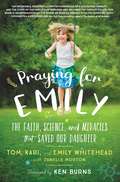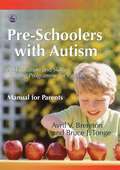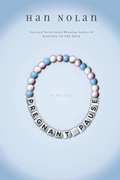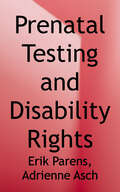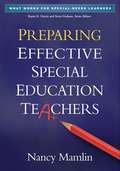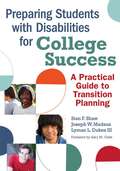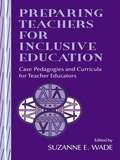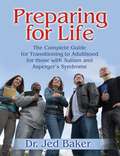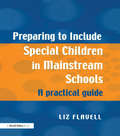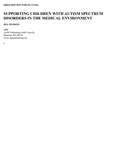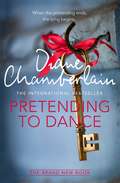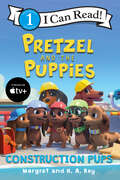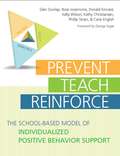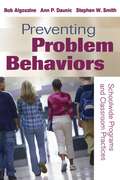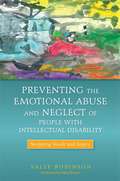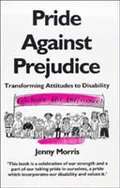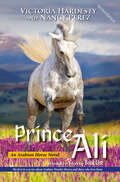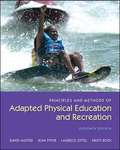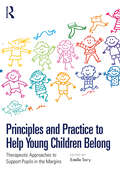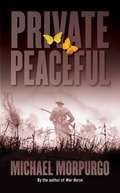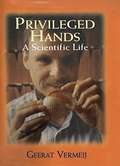- Table View
- List View
Pratibhagi Pustika - Gharelu Data Entry Operator (Divyangjan): प्रतिभागी पुस्तिका - घरेलू डेटा एंटरी ऑपरेटर (दिव्यांगजन)
by Skill Council for Persons with Disabilityइस प्रतिभागी पुस्तिका में दिव्यांगजनों के लिए घरेलू डेटा एंट्री ऑपरेटर की भूमिका और आवश्यक कौशल पर केंद्रित सामग्री दी गई है। इसमें आईटी-आईटीईएस/बीपीएम उद्योग का परिचय, डेटा एंट्री की प्रक्रियाएँ, उपकरण, और सॉफ़्टवेयर आवश्यकताओं के साथ-साथ डेटा सत्यापन, समस्या समाधान, और ग्राहक डेटा प्रबंधन जैसे विषयों को शामिल किया गया है। पाठ्यक्रम संरचना 390 घंटों की प्रशिक्षण अवधि में सिद्धांत (90 घंटे) और प्रायोगिक (300 घंटे) सत्रों को शामिल करती है। यह हैंडबुक डेटा एंट्री ऑपरेटर की जिम्मेदारियों, आवश्यक व्यक्तिगत गुणों और कैरियर विकास मार्गों पर भी चर्चा करती है। साथ ही, रिपोर्ट लेखन, नेटवर्किंग टोपोलॉजी और आधुनिक डेटा एंट्री तकनीकों का वर्णन किया गया है। इस पुस्तक का उद्देश्य प्रतिभागियों को कौशल प्रदान करना है ताकि वे गुणवत्ता मानकों के अनुसार कुशलतापूर्वक कार्य कर सकें।
Praying for Emily: The Faith, Science, and Miracles that Saved Our Daughter
by Tom Whitehead Kari Whitehead Emily WhiteheadDiscover the incredible true story of Emily Whitehead, the first child to receive CAR-T cell treatment for her leukemia -- and learn how her family's faith journey guided them in the fight for her life.When their five-year-old daughter was diagnosed with leukemia, Tom and Kari Whitehead's world was shattered. They vowed to do whatever it took to help their daughter, and as they made decisions about how to best treat her, Tom found his faith coming to him in "whispers," guiding his decisions and keeping his hope alive, while Kari placed great faith in science and the doctors surrounding her little girl. But as Emily's condition continued to worsen, they both prayed for a miracle.Then, their miracle arrived, in the form of an experimental treatment called CAR-T cell therapy that, against all odds, saved Emily's life. Because of Emily's miraculous recovery, this treatment is now used widely to treat cancer and has gone on to save hundreds of lives and promises to help thousands more. For all the acclaim and attention this important new approach to treating cancer has received, few know the full story of all it took to make this miracle happen.In Praying for Emily, the Whiteheads share their story, recounting the belief, resilience, and support that got them through the most difficult time of their lives.
Pre-Schoolers with Autism: An Education and Skills Training Programme for Parents - Manual for Parents
by Avril Brereton Bruce Tonge'The title is an effective, manualized parent education programme' - Educational Book Review This ground-breaking training programme has been developed in response to a real need for evidence-based early interventions for very young autistic children. Authoritative and extensively tried and tested, it will help both parents and carers to understand the disorder and how it affects child development. Ultimately, the programme is designed to reduce the severity of emotional/behavioural difficulties by managing a child's particular problems and encouraging effective collaboration between professionals and parents. The programme is delivered through two accessible manuals - one for parents and one for clinicians - which provide all the information and materials you need. The Manual for Clinicians explains the purpose and content of each session and includes notes for discussion and teaching, a checklist of `things to do', and photocopiable task sheets for distribution and discussion. The Manual for Parents features tasks, exercises and discussion points for group sessions, and complements these training materials with engaging personal accounts, an introduction to the history of autism, information about approaches to treatment, and a list of useful websites and further reading. Structured as a series of individual and small group sessions, the programme is designed to run for 20 weeks and covers key areas such as understanding and managing difficult behaviour; changing/encouraging new behaviours; communication problems in verbal and non-verbal children; social problems; and how to work and play together. Together, these manuals will provide you with all the information, support and resources you need to run this programme successfully.
Pregnant Pause
by Han NolanA thought-provoking and courageous new novel by National Book Award winner Han Nolan. Nobody gets away with telling Eleanor Crowe what to do. But as a pregnant sixteenyear-old, her options are limited: move to Kenya with her missionary parents or marry the baby's father and work at his family's summer camp for overweight kids. Despite her initial reluctance to help out, Elly is surprised that she actually enjoys working with the campers. But a tragedy on the very day her baby is born starts a series of events that overwhelms Elly with unexpected emotions and difficult choices. Somehow, she must turn her usual obstinance in a direction that can ensure a future for herself--and for the new life she has created. The e-book includes a sample chapter from Born Blue by Han Nolan.
Prenatal Testing and Disability Rights
by Adrienne Asch Erik ParensAs prenatal tests proliferate, the medical and broader communities perceive that such testing is a logical extension of good prenatal care--it helps parents have healthy babies. But prenatal tests have been criticized by the disability rights community, which contends that advances in science should be directed at improving their lives, not preventing them. <p><p>Used primarily to decide to abort a fetus that would have been born with mental or physical impairments, prenatal tests arguably reinforce discrimination against and misconceptions about people with disabilities. In these essays, people on both sides of the issue engage in an honest and occasionally painful debate about prenatal testing and selective abortion. <p><p>The contributors include both people who live with and people who theorize about disabilities, scholars from the social sciences and humanities, medical geneticists, genetic counselors, physicians, and lawyers. Although the essayists don't arrive at a consensus over the disability community's objections to prenatal testing and its consequences, they do offer recommendations for ameliorating some of the problems associated with the practice.
Preparing Effective Special Education Teachers
by Nancy MamlinWhat tools are in the toolkit of an excellent special educator, and how can teacher preparation programs provide these tools in the most efficient, effective way possible? This practical, clearly written book is grounded in current research and policy as well as the author's extensive experience as a teacher educator. It identifies what special education teachers need to know to work competently with students with a wide variety of learning challenges and disabilities. Chapters present specific guidelines for helping teacher candidates build critical skills for instruction and assessment, get the most out of field placements, and collaborate successfully with other school personnel and with parents.
Preparing Students with Disabilities for College Success: A Practical Guide to Transition Planning
by Joseph W. Madaus Stan F. Shaw Lyman L DukesFor students with mild to moderate, non-visible disabilities, navigating a college education without the support team they had in high school can be challenging. Help students become effective self-advocates and maximize their postsecondary possibilities with this cutting-edge book, which balances current research with the most practical guidance to date on this topic.
Preparing Teachers for Inclusive Education: Case Pedagogies and Curricula for Teacher Educators
by Suzanne E. WadeThis book--a companion volume to Inclusive Education: A Casebook and Readings for Prospective and Practicing Teachers--is designed to assist instructors in using Inclusive Education as a text for preservice or in-service teacher education courses. Part I (Chapters 1-5) of Preparing Teachers for Inclusive Education provides a general introduction to case pedagogies and chapters describing curricula that teacher educators have developed using cases designed to prepare teachers for inclusive education. Part II provides Teaching Notes that correspond to the 14 cases in Inclusive Education.
Preparing for Life: The Complete Guide for Transitioning to Adulthood for those with Autism and Asperger's Syndrome
by Jed BakerA life skills guide for individuals with autism and Asperger's syndrome discusses social skills and strategies needed for success in the adult world, including discussion of perspective-taking, nonverbal communication skills, and stress management.
Preparing to Include Special Children in Mainstream Schools: A Practical Guide
by Liz FlavellTeachers in both special and mainstream schools have to be confident in their abilities to implement inclusion effectively, in order for the child to have any chance of a successful inclusive school career. This book demonstrates how mainstream and special schools can work together in preparing the special school child to succeed in a mainstream environment. It also shows how to prepare existing mainstream pupils and other members of staff involved in or affected by the inclusion process.The author provides photocopiable forms for evaluating pupils' academic and social process and advice on how physical resources, such as sensory rooms, can enhance the learning opportunities of all pupils. She offers jargon-free communication strategies for effective interaction with the child, which is also considered within the framework of the whole-school policy. The book also presents sample lesson plans, resource ideas and plans for daily record keeping for use across the curriculum subjects; and suggestions for ways in which special and mainstream schools can work together to enhance the whole curriculum. Any teacher in a mainstream or special school who is concerned about making inclusion really work for their pupils will find this book an invaluable companion.
Preschool Orientation and Mobility Screening: Second Edition
by Bonnie Dodson-Burk Christine RomanOutdoor Travel Skills, Gross Motor Skills, Walking Independently, Visual Skills Used for O&M, Auditory Skill, Tactile Skills, Body Image and Exploratory Behavior, Basic Positional Concepts, Home & Community Experiences, Mobility Skills - Walking with Others, Mobility Techniques - Walking Independently, Use of Mobility Devices, Orientation Skills, Background Information.
Prescription for Success: Supporting Children With Autism Spectrum Disorders in the Medical Environment
by Jill HudsonBecause of the unique needs of children with ASD, it is important to pay special attention to the details of their experience in the medical environment. Designed to help make the medical experience easier for all involved, this book presents information on ASD, the varying developmental levels, interventions, and assessments that medical staff, parents, educators, and key service providers can use to more effectively interact with and support children with ASD while in the medical setting.
Prescriptions for Independence: Working with Older People Who Are Visually Impaired
by Nora Griffin-Shirley Gerda GroffPrescriptions for Independence: Working with Older People Who Are Visually Impaired has been designed to provide comprehensive information in a clear and readable way so that visually impaired people, their friends and families, and those who work with them have simple suggestions within easy reach. Readers will find that most people who are visually impaired do have usable vision and do not require special assistance, but they will also find what they need to know about common forms of visual impairment and adaptations and information that are useful to some visually impaired people in daily life.
Pretending to Dance
by Diane ChamberlainBack Cover: "Molly Arnette and her husband live in San Diego, where they hope to adopt a baby. But the process terrifies her. As the background checks begin, Molly worries that secrets from her North Carolina childhood will resurface and destroy not only her chance at adoption but her marriage as well. She ran away from her family twenty years ago after a devastating event left her distrustful of those she loved: her mother, the woman who raised her and who--despite Molly claiming otherwise--is very much alive; her birth mother, whose mysterious presence raised so many issues, and the father she adored, whose death sent her running from the small community of Morrison Ridge. Now, as she tries to find a way to make peace with her past and embrace a future filled with promise, she discovers that even she doesn't know the truth of what happened in her family of pretenders."
Pretzel and the Puppies: Construction Pups (I Can Read Level 1)
by Margret ReyBased on the streaming series Pretzel and the Puppies on Apple TV+, this I Can Read follows the pups as they work to make sure the new Bow Wow Tower is accessible for all dogs.Welcome to Muttgomery, the nicest little city in an all-dog world, and home of Pretzel, Greta, and their five adorable Dachshund puppies: Poppy, Penny, Pedro, Puck, and Paxton. Pretzel is a peppy, playful, and always positive stay-at-home dad, and he and Greta, the mayor of Muttgomery, have a knack for encouraging their pups to follow their passions and make the world a better place!In this I Can Read book, the pups are excited to explore the newly built Bow-Wow Tower—it has binoculars so dogs can see all of Muttgomery! But the construction dogs didn't plan for pups who are too small to reach the binoculars. Luckily the Doxies are there to put their paws up and make the tower accessible to all!Pretzel and the Puppies: Construction Pups is a Level One I Can Read book, which means it’s perfect for children learning to sound out words and sentences. Whether shared at home or in a classroom, the short sentences, familiar words, and simple concepts of Level One books support success for children eager to start reading on their own.
Prevent-Teach-Reinforce: The School-Based Model of Individualized Positive Behavior Support
by Glen Dunlap Rose Lovannone Carie English Donald Kincaid Kelly Wilson Kathy Christian Phillip StrainSolve serious behavior challenges in K-8 classrooms with this easy-to-use book, the first practical guide to the research-proven Prevent-Teach-Reinforce (PTR) model. Developed by some of the most respected authorities on positive behavior support, this innovative model gives school-based teams a five-step plan for reducing problems unresolved by typical behavior management strategies. With this thorough blueprint for PTR, education professionals will learn how to prevent behavior problems by adjusting the curriculum and environment; teach proactive communication skills; and reinforce prosocial behavior and academic achievement. This highly successful model is proven effective by research and field testing in real classrooms PTR was shown to reduce behavior problems and increase evidence of social skills and academic engagement detailed and explicit, with five systematic steps that take educators beyond tips and strategies (see box) consistent with the popular positive behavior support approach and derived from the principles and many procedures of applied behavior analysis easily adaptable to the needs and goals of each individual student effective for a wide variety of students: typically developing students and those who have autism, learning disabilities, intellectual disabilities, emotional and behavioral disorders, and other challenges On the included CD-ROM are all the printable forms and tools needed to implement PTR, such as Behavior Support Plan templates and a Functional Behavioral Assessment. With this comprehensive model, education professionals will resolve even the toughest classroom behavior challenges and remove a significant barrier to effective teaching and student achievement.
Preventing Problem Behaviors: Schoolwide Programs and Classroom Practices
by Bob Algozzine Stephen W. Smith Ann P. DaunicIn today's increasingly diverse PreK-12 classrooms, problem behaviors can often interrupt instructional time and disrupt learning. Designed for 21st-century school leaders, administrators, behavior specialists, and classroom teachers, this research-based guide offers specific strategies and plans for preventing problem behavior at both the classroom and school level. Based on the premise that early response to problems can lead to better outcomes for students, the book's content is framed around four essential areas: foundations, intervention, collaboration, and evaluation. Within these areas, this accessible guide features: -The latest information on the science and practice of prevention -Reasons why conflict resolution, peer mediation, and bully-proofing are essential to prevention -Effective practices for teaching social skills to young children -Proven techniques for implementing schoolwide positive behavior support -Tools for using individual behavior plans to prevent problems -Ideas for home-school and community partnerships and culturally responsible teaching -Critical strategies for monitoring student progress and evaluating prevention practices -New, updated chapters, including information on preschool behavior support and RTI This valuable resource provides all the tools and strategies school leaders and teachers need to keep children focused on learning.
Preventing the Emotional Abuse and Neglect of People with Intellectual Disability
by Sally Robinsonxx
Pride Against Prejudice: Transforming Attitudes to Disability
by Jenny MorrisDrawing on her own and other experiences of disability, Jenny Morris, editor of Able Lives, confronts the nature of the prejudice against disabled people. Pride Against Prejudice challenges the reality of being different, covering current and historical debates on the quality of disabled people's lives; the way disability is represented within Western culture; institutionalisation and independence; feminist research and 'community care'; and the politics of the disability movement. For too long, non-disabled people have defined the experience of disability and had control over disabled people's lives. Pride Against Prejudice has grown out of the increasing collective organisation of disabled people and is part of an emerging disability culture. Jenny Morris argues her case with energy, authority and conviction.
Prince Ali: An Arabian Horse Novel
by Victoria Hardesty and Nancy PerezPrince Ali had everything: talent, charisma, and a devoted best friend, Becky Howard. He won every time he set a hoof in a show ring. He garnered more fans from personal and TV appearances. Becky was with him every step of the way, even riding him in the Swallows Day Parade in their hometown, San Juan Capistrano. Disaster struck when two thugs put Becky in a coma, drugged him and dragged Prince Ali off to sell for diabolical purposes. When their buyer realized who Ali was, he nixed the deal. That landed the pampered show horse high in the mountains in late March. One night, a week later, he discovered the corral gate unlatched. Prince Ali mustered every ounce of strength, courage, and stamina he had to walk into the wilderness searching for the best friend he couldn't live without.
Principles and Methods of Adapted Physical Education and Recreation (11th Edition)
by David Auxter Carol Huettig Jean Pyfer Kristian Roth Lauriece L. ZittelProvides physical educators with up-to-date knowledge and skills to deal with all levels of students' abilities. It is the only text in the adapted physical education market that provides both task-specific and developmental teaching approaches. With the national movement to include most students with disabilities into the general curriculum, the text is designed to enable adapted and regular physical education teachers to successfully address those students' needs in the regular physical education class.
Principles and Practice to Help Young Children Belong: Therapeutic Approaches to Support Pupils in the Margins
by Estelle TarryThis vital resource for early years and primary school trainees and practitioners explores a range of social and therapeutic strategies and interventions that will successfully support all children’s sense of belonging. A sense of belonging is vital to children’s physical, emotional, psychological, mental health and wellbeing. This book considers social and therapeutic strategies and interventions that support all children’s sense of belonging and can be adopted by practitioners. It addresses the interrelated factors that impact children’s sense of belonging such as race, gender, expression of sexual orientation, religion and disabilities. It will help develop practitioners’ awareness of current social and educational issues including LGBT+ topics, the changing family unit, relationships, misogyny and toxic masculinity, meditation and mindfulness as well as the importance of children connecting with nature and transformative activism. The chapters adopt a theoretical and practical approach, presenting case studies of good practice, which will create positive and inclusive outcomes, supporting individual growth and community wellbeing.An essential reading for practitioners, including teachers, teaching assistants (continuing professional development), lecturers and social workers, working in early years and primary educational setting, this book would also be suitable as a core and supportive text for students studying on a variety of undergraduate degree courses within the scope of education, pedagogy, mental health and wellbeing, social work and child development.
Principles of Safeguarding and Protection for Learning Disability Workers
by Simon BickertonIf you are working within the learning disability sector and studying for the QCF Diploma in Health and Social Care, you will find this book invaluable in helping you to achieve the unit on Principles of Safeguarding and Protection. You will learn how to recognise and respond to signs of abuse and how to reduce the likelihood of it happening. The book is easy to navigate, with each chapter covering one of the learning outcomes within the unit. Each chapter begins with an example taken from real people's stories and lots of activities, photographs and other illustrations are included throughout.
Private Peaceful
by Michael MorpurgoAs the enemy lurks in the darkness, Private Thomas Peaceful struggles to stay awake through the night. He has lived through the terror of gas attacks, watched his friends die, and battled the rats, the mud and the sheer exhaustion of staying alert. But in the morning, Thomas will be forced to confront an even greater horror. When morning comes, the unthinkable will happen.

